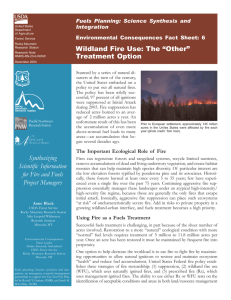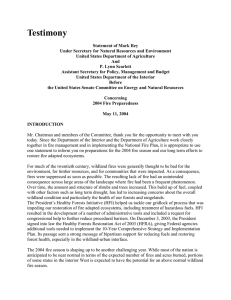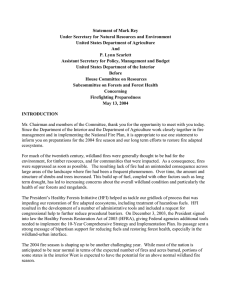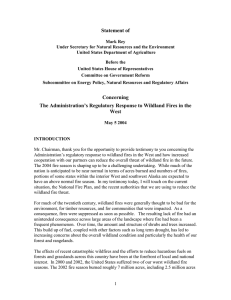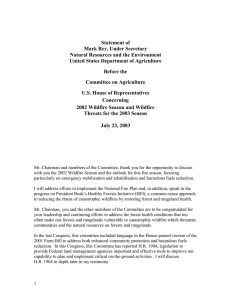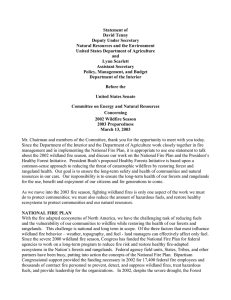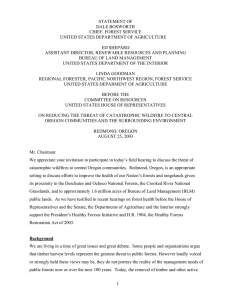The 2003 Season: Record Resources Available to Fight Wildfires;
advertisement
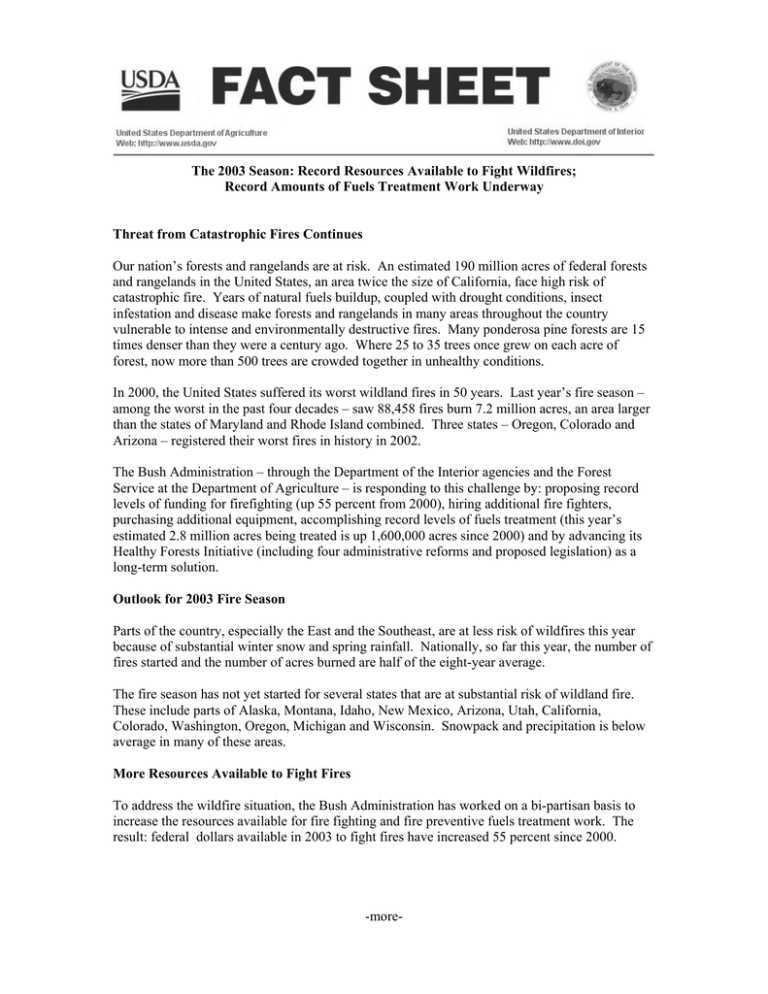
The 2003 Season: Record Resources Available to Fight Wildfires; Record Amounts of Fuels Treatment Work Underway Threat from Catastrophic Fires Continues Our nation’s forests and rangelands are at risk. An estimated 190 million acres of federal forests and rangelands in the United States, an area twice the size of California, face high risk of catastrophic fire. Years of natural fuels buildup, coupled with drought conditions, insect infestation and disease make forests and rangelands in many areas throughout the country vulnerable to intense and environmentally destructive fires. Many ponderosa pine forests are 15 times denser than they were a century ago. Where 25 to 35 trees once grew on each acre of forest, now more than 500 trees are crowded together in unhealthy conditions. In 2000, the United States suffered its worst wildland fires in 50 years. Last year’s fire season – among the worst in the past four decades – saw 88,458 fires burn 7.2 million acres, an area larger than the states of Maryland and Rhode Island combined. Three states – Oregon, Colorado and Arizona – registered their worst fires in history in 2002. The Bush Administration – through the Department of the Interior agencies and the Forest Service at the Department of Agriculture – is responding to this challenge by: proposing record levels of funding for firefighting (up 55 percent from 2000), hiring additional fire fighters, purchasing additional equipment, accomplishing record levels of fuels treatment (this year’s estimated 2.8 million acres being treated is up 1,600,000 acres since 2000) and by advancing its Healthy Forests Initiative (including four administrative reforms and proposed legislation) as a long-term solution. Outlook for 2003 Fire Season Parts of the country, especially the East and the Southeast, are at less risk of wildfires this year because of substantial winter snow and spring rainfall. Nationally, so far this year, the number of fires started and the number of acres burned are half of the eight-year average. The fire season has not yet started for several states that are at substantial risk of wildland fire. These include parts of Alaska, Montana, Idaho, New Mexico, Arizona, Utah, California, Colorado, Washington, Oregon, Michigan and Wisconsin. Snowpack and precipitation is below average in many of these areas. More Resources Available to Fight Fires To address the wildfire situation, the Bush Administration has worked on a bi-partisan basis to increase the resources available for fire fighting and fire preventive fuels treatment work. The result: federal dollars available in 2003 to fight fires have increased 55 percent since 2000. -more- Program Wildland Fire Preparedness Fire Suppression Operations Other Operations: Hazardous Fuel Reduction Rehabilitation and Restoration Fire Facilities Research and Development Joint Fire Sciences Forest Health Management Economic Action Program Community and Private Assistance State Fire Assistance Volunteer /Rural Fire Assistance Emergency Suppression Contingency TOTAL, DOI and USDA 2000 $547,617* 197,256 2003 $887,408 577,273 2004 $892,472 799,890 117,040 20,000 0 0 0 0 0 0 23,929 3,240 390,000 $1,326,088 412,253 26,948 1,838 21,288 7,948 16,824 4,967 0 71,738 23,128 0 $2,051,613 417,582 24,500 0 21,427 8,000 11,934 0 0 71,840 23,283 0 $2,270,928 * Dollars are in the thousands. FY 2000 and 2003 are enacted levels; FY 2004 is the President’s request. These additional dollars have resulted in more firefighting resources being available. As the following chart shows, there are more firefighters, helicopters, airtankers, and heavy equipment to fight fires. This has allowed them to continue to do an outstanding job of fire fighting, controlling over 99 percent of wildfires on initial attack in 2002. Resource Firefighters Type I crews Engines (all types) Dozers/plows/tenders Airtankers Helicopters FY 2000 12,131 68 2,197 286 64 119 FY 2003 15,330 90 2,581 335 72 151 This year, firefighting crews and equipment will be pre-positioned as needed in states to provide effective initial wildfire attack. Additional helicopters and single engine airtankers will be used to provide equivalent protection due to the reduced availability of large, multi-engine air tankers that have been grounded for safety reasons. Record Amounts of Fuels Treatment Work Underway The long-term solution to catastrophic wildfires is to address their causes by reducing fuel hazards and returning our forests and rangelands to healthy conditions. Tree thinning and removal of dense underbrush can ensure thriving forests while reducing risks of catastrophic fires and the dangers they pose to firefighters, private property and communities. The Administration is meeting the challenge. Last year, the Administration set a record in the amount of fuels treatment work done. More than 2.25 million acres were treated. This is a million acres more than were treated in FY 2000. By the end of FY 2003, even more acres – 2,853,000 acres – are projected to be treated. So far this year, 1.4 million acres have been treated, 133,000 acres more than had been treated at this time last year and 531,000 acres more than had been treated in 2001. Still, there is much more work to be done – tens of millions of additional acres are in need of treatment. -more- The President’s Healthy Forests Initiative Being Implemented Over the next several weeks, the Administration will complete the administrative reforms President Bush called for as part of his Healthy Forests Initiative. These improvements include: • establishing new procedures provided for under the National Environmental Policy Act that will enable priority fuels treatment (thinning) and forest restoration (reseeding and planting) projects to proceed quickly. Fuels treatment projects under this procedure must be identified by federal agency experts working in collaboration with state, local and tribal governments and interested persons. Based on the agencies’ experience with over 2,600 projects where environmental analyses showed no significant environmental impact, the procedures will allow similar new projects to proceed without the need for further individual analyses and lengthier documentation; • amending the agencies’ administrative appeal rules to expedite appeals of forest health projects and encourage early and more meaningful public participation. These improvements will reduce complex procedures, provide more timely decisions and provide great flexibility in emergency situations; • expediting consultation by federal agencies on the impacts that fuels treatment projects may have on endangered species; and • implementing the Council on Environmental Quality guidance intended to establish an improved and focused process for conducting environmental assessments, is underway. Fifteen pilot fuels treatment projects using the guidance are expected to be completed this summer. On the legislative front, last year President Bush asked Congress to expand stewardship contracting authority, which Congress granted. These contracts allow contractors to keep wood products in exchange for the service of thinning trees and brush and removing dead wood. Longterm contracts foster a public/private partnership to restore forest and rangeland health by giving contractors the incentive to invest in equipment and infrastructure needed to productively use material generated from forest thinning, such as small-diameter logs, to make wood products or to produce biomass energy, all at tremendous savings to taxpayers. Sixty-two stewardship contracts are projected to be approved this year up from last year’s total of 26. Substantially more stewardship contracts are expected to be approved in FY 2004. Major Improvements to the Wildfire Program Since taking office, the Bush Administration has implemented major reforms to the wildfire program. It reached agreement with Governors, state and local officials and tribes on a 10-year Comprehensive Strategy and Implementation Plan for reducing wildland fire risks to communities, private property and the environment. It established a Wildland Fire Leadership Council including representatives of federal, state, local, and tribal interests to coordinate wildland fire management policies. It required all fuels treatment projects to be collaborated with state and local officials. It developed common performance measures. It developed an automated reporting system for federal agencies to track and measure performance. -more- Action by Congress is Needed The Administration commends the House Agriculture, Judiciary and Resources Committees for passing H.R. 1904, which would provide authorities that are largely consistent with the President’s Healthy Forests Initiative. The Administration strongly supports H.R. 1904 and encourages the House and Senate to complete action on the bill as soon as possible. The legislation would provide additional tools for land managers to help them protect lives and communities, to restore the health of forests and rangelands, to safeguard important wildlife habitat and watersheds. The Healthy Forest Restoration Act establishes procedures to expedite forest and rangeland restoration projects on Forest Service and BLM lands. It focuses on lands (1) near communities in the wildland urban interface, (2) in high risk municipal watersheds, (3) that provide important habitat for threatened and endangered species where wildlife officials have identified catastrophic wildfire as a threat to the survival of the species, and (4) where bugs or disease are destroying the forest and increasing the threat of catastrophic wildfire. It also provides improved timelines for judicial review to ensure that court decisions about critical timesensitive management actions are completed quickly. Additionally, the bill would: • • • • help communities create a cost-effective use for wood, brush and other plant materials removed in forest health projects as a biomass energy fuel supply; authorize a program to support community-based watershed forestry partnerships that address critical forest stewardship, watershed protection and restoration needs at the state and local level; direct additional research focused on the early detection and containment of insect and disease infestations; and establish a private forestland easement program focused on recovering forest ecosystem types and protecting valuable wildlife habitat. To download maps of the wildland fire outlook for 2003, insect infestation nationwide, and charts of fuel treatments by fiscal year, visit www.fs.fed.us. # May 2003




